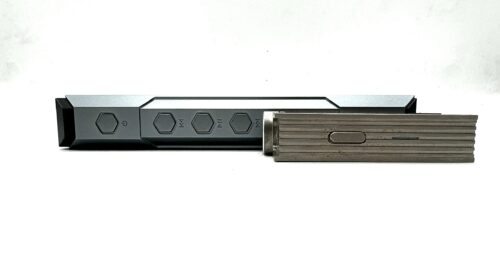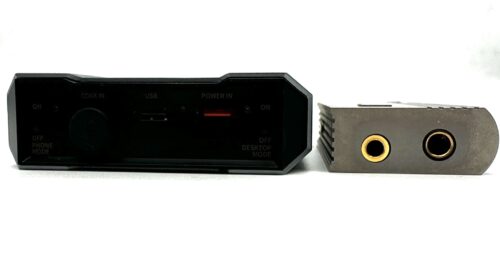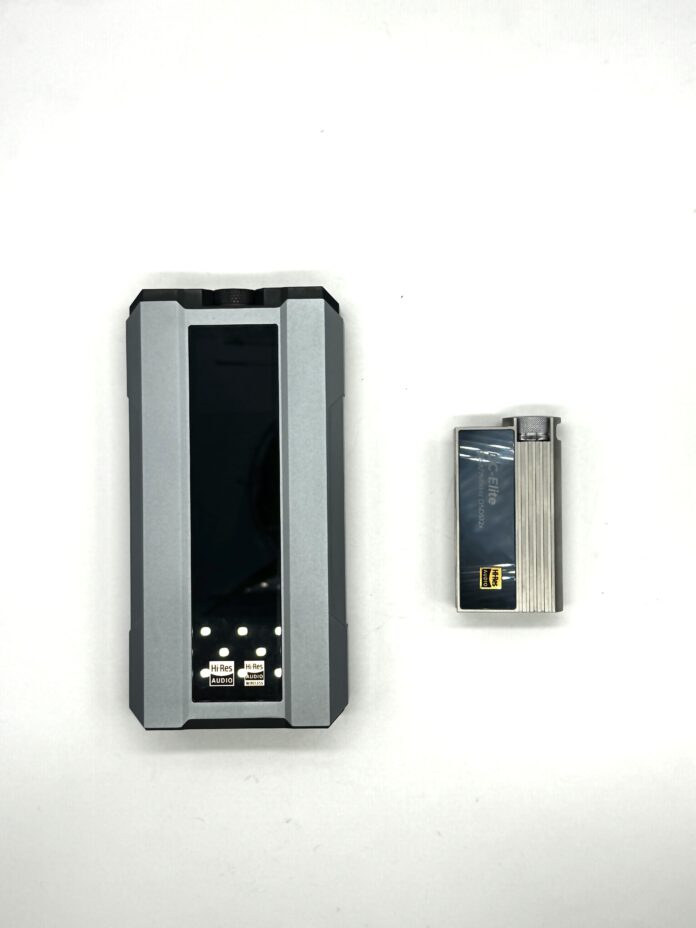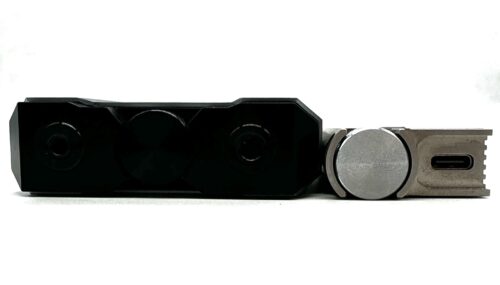Today we have a battle of two mid-fi portable DAC/Amps: the Fiio Q15 and iBasso DC-Elite. While the two devices are similar in price and sound quality, there are many differences as well. Functionality, size, power, and other factors play into the decision between the two devices. In this review, we’ll break down what’s similar and what’s different between the Q15 and DC-Elite. Then we’ll get into who each product may be best for. So let’s jump into the review.
What’s in the Boxes:
| Fiio Q15 | iBasso DC-Elite |
|
|

Build:
Both the Q15 and DC-Elite boast great builds. But the ways they achieve their builds are quite different. The Q15 is a large device, similar to a thick smartphone. Its metal and glass design sparks confidence that it could survive any drop. Meanwhile, the DC-Elite features similar materials, but at a smaller form factor.
The Q15 features basic power and play/pause/volume controls, and even the volume pot also acts as a menu button. The Q15 sports 3.5mm and 4.4mm headphone outputs, with USB Type-C and Coax inputs on the opposite end. Controls for digital filters and PEQ, among other settings, can be found in the menu system using the volume pot (which lights up by the way). Of course there’s also a full color IPS display that lets you know what file type you’re playing as well as which input mode you’re in (Bluetooth or wired) among other details.
Finally, there is a second Type-C input meant solely for an external power supply. You may want to have an external power supply ready to go when using desktop mode so as not to chew through the battery. Finally we have switches for phone mode (which uses the phone’s battery rather than the Q15’s in-built battery).
The DC-Elite is a little bit simpler. It features 3.5 and 4.4 mm outputs as well as a USB-C input. It also has a button on the side for making micro-adjustments to volume. There’s also a light that shines red when not playing any audio, and green when music is playing. And that’s just about where the I/O and build features stop. There is, however, an awkward shield around the volume pot. This helps keep the pot safe from damage, but does make it less easily accessible.

Design
The Fiio Q15 uses a dual AKM DAC combo (AK4191EQ + AK4499EX). The device also uses an XMOS 16-Core XU316 and supports 768kHz/32 bit PCM, DSD512, and MQA full decoding. The Q15 is helped by dual audio crystal oscillators to help adapt to these sample rates. In Desktop Mode, the Q15 is capable of up to 1600 mW of power, which is plenty for driving any type of headphone.
Meanwhile, the DC-Elite is powered by a ROHM BD34301EKV chipset. This is considered a desktop-level component. Thus, it is capable of very high sample rates. The DC-Elite scales up to 768kHz/32 bit PCM and DSD512. Notably, there is no full MQA decoding as is found on the Fiio device
For the DC-Elite, an in-house FPGA algorithm reduces jitter with support from an NDK femtosecond oscillator which also helps to lower distortion. Power-wise, the DC-Elite does a smaller maximum 280 mW. I found this to still be plenty powerful for driving a full range of headphones, but it should be noted that it is less powerful than the Q15, especially when in Desktop Mode.
Functionality
A major difference between the Q15 and DC-Elite is that the Q15 can execute on all of its features internally. That means you can adjust digital filters, gain, max volume, PEQ, and other features right in the device. Meanwhile, you can control similar settings, though there are fewer of them, through iBasso’s app for the DC-Elite. It should be noted that this app is only available for Android – I was not able to access the app for my iPhone 15.
In iBasso’s UAC app, you can control the digital filter and roll-off, PCM volume reduction, DSD filters and SPDIF mode. The options are limited compared to the Q15, so if you’re looking for a feature-rich device that offers great listening flexibility, the Q15 is probably the winner here.
Sound Impressions
So now that we know that internally these devices are quite different from each other, it’s time to look at how they compare in terms of sound. I’m happy to say that both the Q15 and DC-Elite are great sounding portable DAC/Amps. That said, they are both distinct in their own ways, and we’ll break that down here.
Lows:
Starting with the low end, the Q15 has a little bit more rumble. This is a more assertive and forward-sounding approach than the DC-Elite. Listening on a laid back headphone like the Final Audio D7000, I got a greater sense of punch and slam. And on headphones like the Meze Liric II, it made for a warm and fun sound that I really enjoyed.
However, with the DC-Elite, you get a more laid back approach that prioritizes details over being visceral. However, there’s still plenty of low end extension and attack. In fact, the bass can really sneak up on you with the DC-Elite.
So if you prefer a more tactile and aggressive bass response, the Q15 is probably your choice. But if you want a smooth sound that brings out more nuance in the sound, while being a little more relaxed, the DC-Elite may be more your speed.
Mids:
I found both DAC/Amps to have lush midranges. On the Q15, vocals are warm and forward. In fact, on headphones like the D7000, I found it to be a bit too forward for my taste. But with the Liric II and Campfire Bonneville, I found the musicality of the midrange to be really pleasant to the ear.
The DC-Elite on the other hand is once again a bit more delicate and unobtrusive, opting for clearer layering and better separation than the Q15. Now, I do want to clarify that this is a smaller difference than it seems. The midrange on both the Q15 and DC-Elite appeared to be quite similar in my opinion. I would say the DC-Elite has better detail retrieval and separation while the Q15 has a bit more musicality and attack.
Highs:
The breakdown of the top end is quite similar to the midrange and lows. The Q15 is once again more in your face while the DC-Elite offers you some distance from the sound and a little more room to be enveloped in. The Q15 is a bit more crisp while the DC-Elite is softer.
If you’re a treble-head, the Q15 might offer a bit more of a forward sound and you may prefer that. But if you like a more delicate treble response, the DC-Elite may be a better choice.
Soundstage:
This is where I found the two devices to be most different. The Q15 is by no means a narrow sounding device, but the way the DC-Elite presents space is second to none. Where music is well-separated on the Q15, it’s almost floating in space entirely on the DC-Elite. The DC-Elite’s imaging feels more natural and nuanced than the Q15 as well.
So soundstage-driven audiophiles may want to opt for the DC-Elite. That said, if you are into that more forward sound the Q15 offers, I wouldn’t see this as a problem. Soundstage is by no means bad on the Q15, and it still sounds natural when paired with that more aggressive sound signature the Q15 offers.
Summary
In total, these two portable DAC/Amps are high performers. The Q15 is more feature-rich and can blast you with power, and hits you with an overt sound that many will find exciting. Meanwhile, the DC-Elite is a little more you-get-what-you-see, while having a more nuanced and detailed sound. If I had to pick one, I’d say the DC-Elite gives a more mature sound signature and the smaller form factor makes it a great pick for me. However, the Q15 is no slouch, and if you want its bevy of features (like Bluetooth, in-built filters and EQ, and vast power), then the Q15 is still a fantastic choice.
The Fiio Q15 and iBasso DC-Elite are both available at Audio46.
MAJORHIFI may receive commissions from retail offers.









